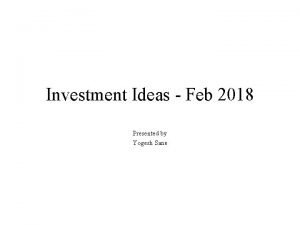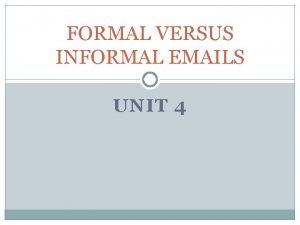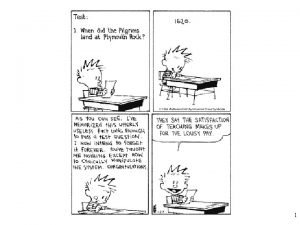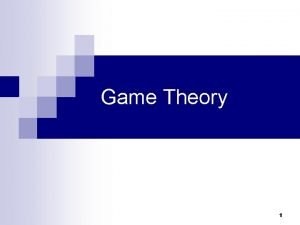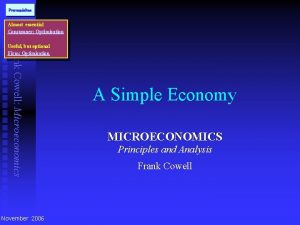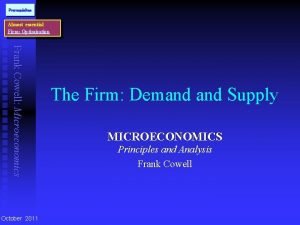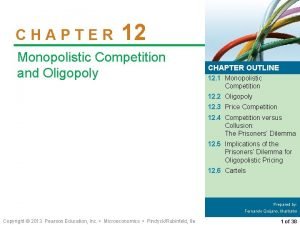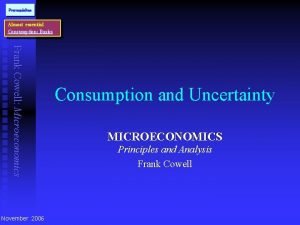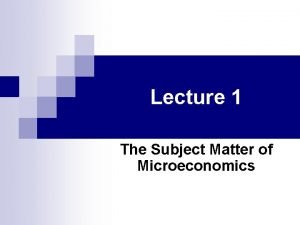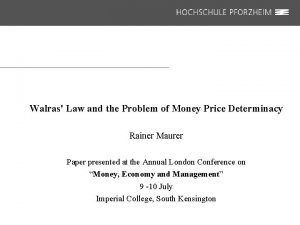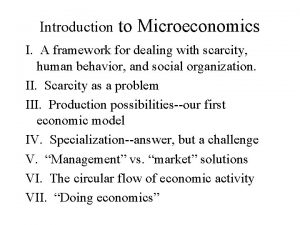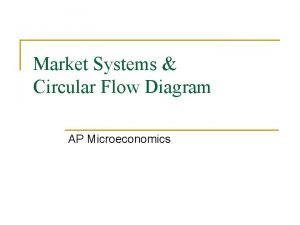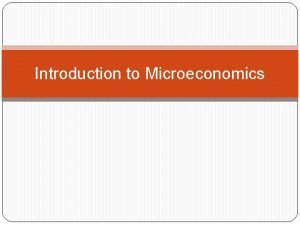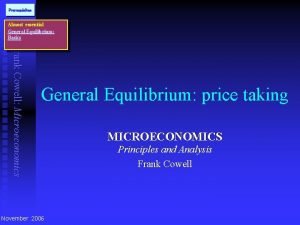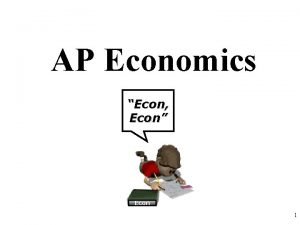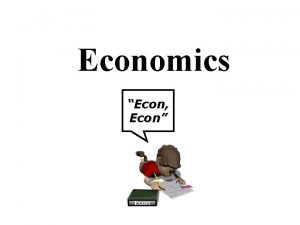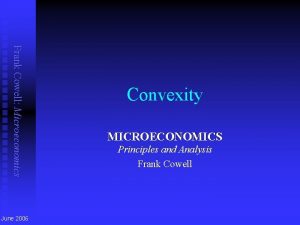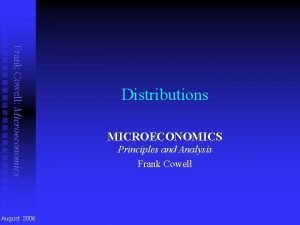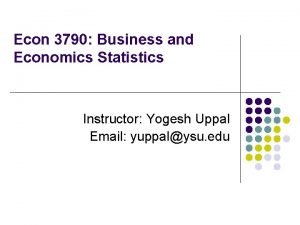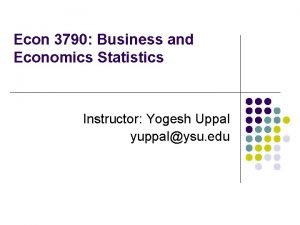Econ 2610 Principles of Microeconomics Yogesh Uppal Email






































- Slides: 38

Econ 2610: Principles of Microeconomics Yogesh Uppal Email: yuppal@ysu. edu

Chapter 3 Supply and Demand Mc. Graw-Hill/Irwin 3 -2 © The Mc. Graw-Hill Companies, Inc. , 2009

Learning Objectives: Understand how 1. 2. 3. 4. 5. 6. Demand curves show buyers' market behaviors. Supply curves show sellers' market behaviors. Supply and demand determine equilibrium price and quantity. Shifts in supply and demand change equilibrium outcomes. The Efficiency Principle says growth makes it possible for each person to have more. The Equilibrium Principle says market equilibrium leaves no unexploited opportunities for individuals. Mc. Graw-Hill/Irwin 3 -3 © The Mc. Graw-Hill Companies, Inc. , 2009

What, How, and For Whom? l Every society answers three basic questions WHAT § Which goods will be produced? § How much of each? HOW § Which technology? § Which resources are used? FOR § How are outputs distributed? § Need? WHOM § Income? Mc. Graw-Hill/Irwin 3 -4 © The Mc. Graw-Hill Companies, Inc. , 2009

Central Planning v. Market l Central Planning Decisions by individuals or small groups Agrarian societies l Government programs Sets prices and goals for the group l Individual influence is limited l l The Market l l Buyers and sellers signal wants and costs l Resources and goods are allocated accordingly Interaction of supply and demand answer the three basic questions Mixed economies use both the market and central planning Mc. Graw-Hill/Irwin 3 -5 © The Mc. Graw-Hill Companies, Inc. , 2009

Buyers and Sellers in the Market l Buyers and sellers have different motivations l l l Market: people who buy and sell the good l l Buyers want to benefit from the good Sellers want to make a profit Buyers and sellers jointly determine outcome Market price balances two forces l l Value buyers derive from the good Cost to produce one more unit of the good Mc. Graw-Hill/Irwin 3 -6 © The Mc. Graw-Hill Companies, Inc. , 2009

Demand l l The quantity buyers would purchase at each possible price Demand curve l Negative slope l l Consumers buy less at higher prices Consumers buy more at lower prices Mc. Graw-Hill/Irwin Demand for Pizzas P $4 $2 D 8 16 Q (000 s of slices/day) 3 -7 © The Mc. Graw-Hill Companies, Inc. , 2009

Demand Slopes Downward l Buyers value goods differently l l Reservation price: the highest price an individual is willing to pay for a good Demand reflects the entire market, not one consumer l l Lower prices bring more buyers into the market Lower prices cause existing buyers to buy more Mc. Graw-Hill/Irwin 3 -8 © The Mc. Graw-Hill Companies, Inc. , 2009

Income and Substitution Effects l l Buyers buy more at lower prices and buy less at higher prices What happens when price goes up? l l The substitution effect: Buyers switch to substitutes when price goes up The income effect: Buyers' overall purchasing power goes down Mc. Graw-Hill/Irwin 3 -9 © The Mc. Graw-Hill Companies, Inc. , 2009

Interpreting the Demand Curve l Demand for Pizzas P Horizontal interpretation of demand l Given price, how much will buyers buy? $4 $2 D 8 16 Q (000 s of slices/day) Mc. Graw-Hill/Irwin 3 -10 © The Mc. Graw-Hill Companies, Inc. , 2009

Interpreting the Demand Curve l Demand for Pizzas P $4 $2 Vertical interpretation of demand l Given the quantity to be bought, what will the price be? D 8 16 Q (000 s of slices/day) Mc. Graw-Hill/Irwin 3 -11 © The Mc. Graw-Hill Companies, Inc. , 2009

Movement along the Demand Curve l Demand for Pizzas P l $4 $2 D 8 16 (000 s of slices/day) Q l When price goes up, quantity demanded goes down When price goes down, buyers move to a new, higher quantity demanded A change in quantity demanded results from a change in the price of a good.

Causes of Shifts in Demand l Price of complementary goods l Tennis courts and tennis balls l Price of substitute goods l Internet and overnight delivery l Income: normal or inferior goods? l Preferences l Dinosaur toys after Jurassic Park movie l Number of buyers in the market l Expectations about the future Price changes never cause a shift in demand

Shift in Demand l If buyers are willing to buy more at each price, then demand has increased l Move the entire demand curve to the right l Increase in demand l If buyers are willing to buy less at each price, then demand has decreased Demand for Pizzas P $2 D 16 20 (000 s of slices/day) D' Q

The Supply Curve l The quantity of a good that sellers offer at each price Supply of Pizzas P S l $4 $2 l 8 16 (000 s of slices/day) Q The higher the price, the higher the quantity supplied. The supply curve has a positive slope.

Interpreting the Supply Curve l Supply of Pizzas P S Horizontal interpretation of supply l Given price, how much will suppliers offer? $4 $2 8 16 Q (000 s of slices/day) Mc. Graw-Hill/Irwin 3 -16 © The Mc. Graw-Hill Companies, Inc. , 2009

Interpreting the Supply Curve l Supply of Pizzas P S $4 Vertical interpretation of supply l Given the quantity to be sold, what will the price be? $2 8 16 Q (000 s of slices/day) Mc. Graw-Hill/Irwin 3 -17 © The Mc. Graw-Hill Companies, Inc. , 2009

Changes in Quantity Supplied l When the price of a good changes, move to a new quantity supplied everything except price is held constant P Supply of Pizzas S $4 l Assumes $2 8 16 (000 s of slices/day) Q

Causes of Shifts or Changes in Supply l. A change in the price of an input l Fiberglass for skateboards, construction wages l A change in technology l Desktop publishing and term papers l Internet distribution of products (e-commerce) l Weather (agricultural commodities and outdoor entertainment) l Number of sellers in the market l Expectation of future price changes Price changes never cause a shift in supply

Changes in Supply l Supply increases when sellers are willing to offer more for sale at each possible price l Moves the entire supply curve to the right l Supply decreases when sellers are willing to offer less for sale at each possible price l Moves the entire supply curve to the left Supply of Pizzas P S* S S' $2 $2 8 9 (000 s of slices/day) Q

Market Equilibrium l Price where market demand intersects market supply l l Quantity supplied equals quantity demanded No tendency to change P or Q Market for Pizzas P S $3 D 12 Q (000 s of slices/day) Mc. Graw-Hill/Irwin 3 -21 © The Mc. Graw-Hill Companies, Inc. , 2009

Excess Supply and Excess Demand Excess Supply l At $4, 16, 000 slices supplied and 8, 000 slices demanded l At $2, 8, 000 slices supplied 16, 000 slices demanded Market for Pizzas P P Surplus S S $4 Shortage $2 D 8 16 (000 s of slices/day) Mc. Graw-Hill/Irwin D Q 8 16 Q (000 s of slices/day) 3 -22 © The Mc. Graw-Hill Companies, Inc. , 2009

Incentive Principle: Excess Supply at $4 l l l Each supplier has an incentive to decrease the price in order to sell more Lower prices decrease the surplus As price decreases: l the quantity offered for sale decreases along the supply curve l the quantity demanded increases along the demand curve Mc. Graw-Hill/Irwin Market for Pizzas P S $4 $3. 50 $3 Equilibrium D 8 12 16 Q (000 s of slices/day) 3 -23 © The Mc. Graw-Hill Companies, Inc. , 2009

Incentive Principle: Excess Demand at $2 l Market for Pizzas P l S $3 $2. 50 $2 Equilibrium D 8 12 16 (000 s of slices/day) Mc. Graw-Hill/Irwin Q Some consumers have an incentive to offer a higher price. As price increases l the quantity offered for sale increases along the supply curve l As price increases, the quantity demanded decreases along the demand curve. 3 -24 © The Mc. Graw-Hill Companies, Inc. , 2009

Rent Controls Are Price Ceilings l l l Rent controls set a maximum price that can be charged for a given apartment If the controlled price is below equilibrium, then l Quantity demanded increases and l Quantity supplied decreases A shortage results Mc. Graw-Hill/Irwin Market for NYC Apartments P S $1, 600 $800 D 1 2 3 Q (millions of apartments/day) 3 -25 © The Mc. Graw-Hill Companies, Inc. , 2009

Changes in Equilibrium Ex: Tennis Market l If rent for tennis court decreases, demand for tennis balls increases l P Tennis courts and tennis balls are complements Tennis Court Rentals P Tennis Ball Sales S $10 $1. 40 $1. 00 $7 D' D D 4 11 (00 s rentals/day) Mc. Graw-Hill/Irwin Q 40 58 Q (millions of balls/day) 3 -26 © The Mc. Graw-Hill Companies, Inc. , 2009

Apartments Near DC Metro l Convenient Apartments P D D' S P' If government wages rise, demand for apartments near Metro stations increases l Demand increases § § P l Q Q' (units/month) Mc. Graw-Hill/Irwin Q Price increases Quantity increases Demand for a normal good increases when income increases l Demand for an inferior good increases when income 3 -27 decreases © The Mc. Graw-Hill Companies, Inc. , 2009

Shifts in Supply: Skateboards l l l Costs of production affect the supply of a product Cost of fiberglass for skateboards increases l Supply decreases With no change in demand, the price of skateboards Supply of Skateboards increases to $80 and quantity P S' decreases to 800 S $80 $60 D 600 800 1, 000 Q (skateboards/month) Mc. Graw-Hill/Irwin 3 -28 © The Mc. Graw-Hill Companies, Inc. , 2009

Shift in Supply: Home Construction l Cost of labor used to produce houses decreases l Supply increases The Market for New Houses l Demand is constant l The price of houses P S decreases to $90, 000 S' $120 per house $90 l Quantity increases to 50 D 40 50 Q (houses/month) Mc. Graw-Hill/Irwin 3 -29 © The Mc. Graw-Hill Companies, Inc. , 2009

Supply and Demand Shifts: Four Rules An increase in demand will lead to an increase in both equilibrium price and quantity P S P' P D' D Q Mc. Graw-Hill/Irwin Q' Q 3 -30 © The Mc. Graw-Hill Companies, Inc. , 2009

Supply and Demand Shifts: Four Rules An decrease in demand will lead to a decrease in both equilibrium price and quantity P S P P' D D' Q' Mc. Graw-Hill/Irwin Q Q 3 -31 © The Mc. Graw-Hill Companies, Inc. , 2009

Supply and Demand Shifts: Four Rules An increase in supply will lead to a decrease in the equilibrium price and an increase in the equilibrium quantity. P S S' P P' D Q Mc. Graw-Hill/Irwin Q' Q 3 -32 © The Mc. Graw-Hill Companies, Inc. , 2009

Supply and Demand Shifts: Four Rules An decrease in supply will lead to an increase in the equilibrium price and a decrease in the equilibrium quantity. S' P S P' P D Q' Mc. Graw-Hill/Irwin Q Q 3 -33 © The Mc. Graw-Hill Companies, Inc. , 2009

Supply and Demand Both Change: Tortilla Chips § Oils used for frying are harmful AND the price of harvesting equipment decreases Price ($/bag) S S' P P' D D' Q' Q Millions of bags per month Mc. Graw-Hill/Irwin 3 -34 © The Mc. Graw-Hill Companies, Inc. , 2009

Changes in Supply and Demand Supply Demand Increases Decreases Increases P Q Depends Increases P Q Increases Depends Decreases P Q Decreases Depends P Q Depends Decreases Mc. Graw-Hill/Irwin 3 -35 © The Mc. Graw-Hill Companies, Inc. , 2009

Efficiency and Equilibrium l Markets communicate information effectively l l Value buyers place on the product Opportunity cost of producing the product Markets maximize the difference between benefits and costs Market outcomes are the best provided that l l The market is in equilibrium AND No costs or benefits are shared with the public Mc. Graw-Hill/Irwin 3 -36 © The Mc. Graw-Hill Companies, Inc. , 2009

Cash on the Table l l Buyer's surplus: buyer's reservation price minus the market price Seller's surplus: market price minus the seller's reservation price Total surplus = buyer's surplus + seller's surplus l Total surplus is buyer's reservation price – seller's reservation price No cash on the table when surplus is maximized l No opportunity to gain from additional sales or purchases Mc. Graw-Hill/Irwin 3 -37 © The Mc. Graw-Hill Companies, Inc. , 2009

Efficiency Principle l l l Socially optimal quantity maximizes the total surplus for the economy from producing and selling a good l Economic efficiency -- all goods at their socially optimal level Efficiency Principle: equilibrium price and quantity are efficient if l Sellers pay all the costs of production l Buyers receive all the benefits of their purchase Efficiency: marginal cost equals marginal benefit l Production is efficient if total surplus is maximized Mc. Graw-Hill/Irwin 3 -38 © The Mc. Graw-Hill Companies, Inc. , 2009
 Yogesh uppal
Yogesh uppal Polluter
Polluter Yogesh uppal
Yogesh uppal Economists assume that firms seek to
Economists assume that firms seek to Yogesh sane
Yogesh sane Yogesh kalyani
Yogesh kalyani Pavandeep uppal
Pavandeep uppal Rent principles of microeconomics
Rent principles of microeconomics Email formal informal
Email formal informal Pure public good
Pure public good Unit 1 basic economic concepts
Unit 1 basic economic concepts What is microeconomics
What is microeconomics Game theory
Game theory Frank cowell microeconomics
Frank cowell microeconomics Objectives of microeconomics
Objectives of microeconomics Intermediate microeconomics lecture notes
Intermediate microeconomics lecture notes Cowell microeconomics
Cowell microeconomics Economics subject
Economics subject Cowell microeconomics
Cowell microeconomics Define macroeconomics
Define macroeconomics Cowell microeconomics
Cowell microeconomics Microeconomics examples
Microeconomics examples Almost essential
Almost essential Cartel microeconomics
Cartel microeconomics Intermediate microeconomics notes
Intermediate microeconomics notes Cowell microeconomics
Cowell microeconomics Microeconomics chapter 12
Microeconomics chapter 12 Parkin macroeconomics 13th edition pdf
Parkin macroeconomics 13th edition pdf What is the subject matter of microeconomics
What is the subject matter of microeconomics Cowell microeconomics
Cowell microeconomics Microeconomics
Microeconomics Walras’ law
Walras’ law Microeconomics ia
Microeconomics ia Circulair flow marketing
Circulair flow marketing Cowell microeconomics
Cowell microeconomics What is macroeconomics
What is macroeconomics Significance of microeconomics
Significance of microeconomics Almost essential
Almost essential Uses of microeconomics
Uses of microeconomics




